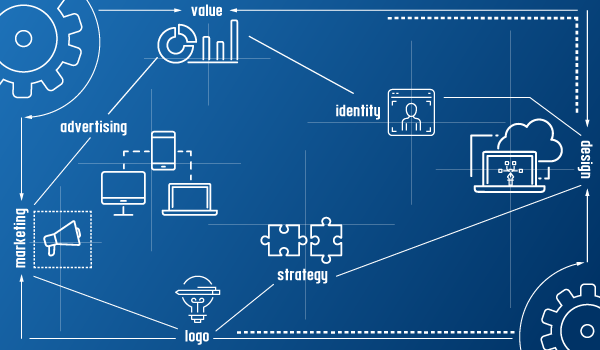Are you ready to overhaul your brand?
If you’re falling behind competitors or struggling to reach consumers, tweaking your image can often seem like an attractive remedy.
But before your marketing team starts debating catchy slogans or haggling over sleeker logo designs, it’s important to know if rebranding is really the best solution to what is ailing your business.
If you are set on taking your business in a new direction, it’s critical to understand what’s involved in the company rebrand process—including the time, effort and resources needed to execute an effective rebranding strategy on your own.
What does rebranding mean?
Rebranding is the act of cultivating a new perception or identity for your brand in the hearts and minds of your stakeholders. More than just a marketing strategy, rebranding your business may involve a simple or extensive combination of changes designed to influence how consumers, competitors and investors see and feel about your company, including changes to brand name, concept, symbol, design and more.
A successful rebranding approach may include:
- Adopting a new name
- Designing a new brand image
- Retooling your logo
- Reframing your products and services
- Overhauling your marketing strategy
- And more
Pulling off an effective rebrand doesn’t necessarily have to involve one or more of the above factors. But no matter the size, scope or type of changes you’re looking to make, a robust rebranding strategy should always rest on an adequate foundation of planning, research, workforce and budget—resources to note on your rebranding checklist before taking the next step.
Why do companies rebrand themselves?
Here are the seven top reasons companies rebrand themselves:
- Negative reputation
Bad articles, reviews and press can threaten brand survival and create the need for major change.
- New leadership
Changes in leadership bring with them new opportunities to repair past mistakes and improve perception.
- Repositioning
Rebranding can help businesses improve appeal among new and existing audiences.
- Organizational growth
Major events like mergers and acquisitions often go hand-in-hand with brand realignment.
- Inconsistent identity
A confusing or incomplete identity can create problems only a rebrand can fix.
- Image refresh
Image updates ensure brands stay modern, relevant and aligned with what they offer.
- Market changes
Keeping up with changing markets means evolving your brand and adapting when necessary.
Whatever the reason, changing your corporate identity is often a critical, if not essential, tool for surviving an unpredictable, ever-shifting marketplace. The right rebranding strategy can restore confidence in and connection with your business, as well as to build the critical competitive advantage needed to achieve your long-term goals.
As you prepare your rebranding process checklist, be sure to keep your rebrand rationale clearly in focus. Knowing what spurred on the need for change helps ensure your strategy stays on track and produces the intended effect.
How to rebrand a company
Successfully rebranding your company requires a firm grasp of your resources, organizational commitment and why you’re pursuing a business rebrand in the first place. Once you know what you can commit and what you want to accomplish, you can then customize the rebranding strategy aligned with your corporate vision, mission and long-term objectives.
In other words, building a careful rebranding approach involves:
- Knowing the reason behind your rebrand
- Understanding your corporate values and mission
- Crafting a rebrand strategy around organizational principles and goals
- In-depth research of your position in the marketplace, as well as among competitors
- Knowing the amount of time, money and personnel to execute your strategy
- Assembling the team(s) you can trust to reposition your company effectively
Rebrands require a high level of buy-in and expertise not just to ensure they’re done correctly, but also to avoid potential gaps or mishaps that may expose your business to issues down the road. By building a robust framework right at the start, you’re on your way to developing an image that inspires and cultivates positive, meaningful connections with your audience.
What to consider when rebranding
There are many things to consider when putting together your rebranding checklist. Here are ten of the most important:
1. Why you’re rebranding
As we explored earlier, there are numerous reasons you might want to rebrand your business. And knowing what or why you’re rebranding is essential to keeping your strategy on point and focused on your long-term goals.
Are you rebranding to reach a new audience, or to retain an existing one? Are you building around a new product or service? Or are you merely trying to pivot to keep pace with a changing market and maintain brand relevance?
Whatever your motivation, make sure it’s front and center as you take on this new endeavor. When you have a clear objective, it’s much easier to avoid alienating your stakeholders and work toward meeting your objectives.
2. What’s working for your competition
Knowing what’s working and not working for your competitors provides insight into what to avoid and how to stand out.
Researching your competition beforehand not only ensures your logo, tagline or name change will be original, but also helps identify any branding pathways that are worn out—as well as rebranding opportunities your competitors might be missing.
The research process may also reveal the success or failure of past rebranding efforts taken on by your competitors, allowing you to learn from past mistakes and providing a helpful leg-up in the fight to establish a more dominant brand name.
3. Who is your audience
It may go without saying, but brand-building is all about messaging to the desired audience. And as a brand-building exercise, successful image reinvention is only possible when you know who your audience is, what they want and how to cultivate a brand that captures their trust and delivers results.
A robust rebranding framework isn’t built on guesswork or assumption, but on customer interviews, statistics and insight that inform and fortify your approach each step of the way. Setting aside time to vet your audience and build accurate customer profiles may seem like busywork, but without it, your strategy will likely miss its mark and fall apart fast.
4. What is your mission
Your values and mission statement are what anchor your company and put your principles into focus. Unfortunately, they’re often placed on the backburner during the rebranding process, creating a disconnect that can damage integrity and force an agonizing and costly reassessment of strategy.
Whether your goal is to deliver the area’s best tasting tacos or deliver 100% customer satisfaction, your mission is and should be a crucial point of emphasis throughout your company rebrand. Keeping each in alignment helps avoid conflicts in messaging and provide purpose to your efforts.
And if you find your rebrand and mission don’t mix—but are a big believer in what your new brand will bring—it may be time to reevaluate and adjust your core message to better fit your new approach.
5. What is your budget
Businesses rebrand all the time and for many reasons. But without the proper level of investment across different communication channels—particularly digital marketing, social platforms and online advertising—it’ll be hard to launch that new brand with the force it needs to maximize impact.
Ask yourself: what am I budgeted for? Do I have what’s needed to make this work? At the very least, a major brand pivot requires a minimum investment in multiple areas to be truly effective.
When you factor what you have and what’ll need, be sure to consider the commitment of time and labor needed to perform your brand facelift.
6. What changes are necessary (and things that can stay)
When it comes to rebranding, it’s sometimes pretty obvious what is losing traction among your audience—or creating such a hazard as to threaten your company’s very existence.
For example, all signs could be pointing to an outdated logo, irrelevant slogan or inactive social media strategy as a primary target for reinvention, something that not only needs a lot of work, but requires an entirely different approach for bringing it up-to-date and in line with your new strategy.
But others—such as a user-unfriendly website or overlooked product flaw—may not be as striking (at least not at first), necessitating a bit more scrutiny before they can be identified and properly dealt with.
What’s more: it’s likely that not everything about your current image needs the full rebranding treatment and would perhaps be better served (and more cost-efficient) as elements of your new approach.
The point? When crafting your rebranding strategy, weigh the costs/benefits of changing each element carefully and before you go in at full steam.
7. Your design team
Design is one of those intangibles that sometimes hits the mark and sometimes hits the wall. Still, choosing the wrong design team to update your logo or refresh your website is likely to sink your rebrand before it can swim, forcing a painful reevaluation of your entire effort.
Choosing and thoroughly vetting experienced web and brand designers is essential to bringing your rebranding ideas to life. Design provides a critical visual element that triggers and nurtures brand recognition quickly—and the right design team could be the fuel that powers your strategy over the top.
8. How your rebranding checklist accounts for ROI
Will your rebranding efforts generate enough revenue and shore up enough losses to rationalize what you’re putting into it? Do you anticipate the benefits of your new brand to outweigh the costs (money, time, resources) of getting it done successfully?
As you strategize your rebrand, analyze the returns it will deliver in terms of attracting new business, strengthening customer loyalty and retaining high-quality staff. Determine what kind of ROI you can expect after implementation and any areas you can improve those numbers before taking the plunge.
As with any business strategy, you want to make sure the effort is worth your organization’s time.
9. How you market your new brand
Of course, consumers, competitors and employees know you as you are. But when changes are thrown at them suddenly and without warning—or are unclear and confusing—you’re likely to leave them a bad taste that lingers and undercuts your efforts for months or even years to come.
How your stakeholders react to your new brand is an important thing to consider when rebranding, as well as what methods you take to prepare them for the news and ensure the smoothest transition possible.
Having a good strategy for unveiling your new changes allows you to control the narrative and minimize any potential backlash you may receive for moving in a new direction. Smart, impactful marketing is what eliminates surprises and makes your new image palatable to the public.
10. Your next rebrand
There’s no way to really tell what the future holds for your company. But chances are that if your organization is healthy and around for any amount of time, you will probably need another rebrand or two in the years ahead. And when that happens, you will be glad you set a sturdy foundation within the rebranding strategy you’re executing now.
Regardless of what they end up being, anticipating future rebrands provides the mindset needed to make flexibility a core component of your current approach. And by leaving wiggle room within your strategy, you’re able to adapt your brand to an ever-changing landscape faster and easier, expediting future efforts and reducing rebrand and marketing costs in the process.
To rebrand or not to rebrand: Signs it’s time for a change
It’s not always obvious or easy to tell when it’s time for a new brand.
But here are a few signs that a brand refresh may be what’s needed to pump new life into your business:
1. You are indistinct from the competition
Standing out is central to winning customer attention and growing your business. However, sometimes it can begin to feel like you’re unable to separate your company from your competitors, as though you’re just one drop in a vast industry sea with nowhere or way to set yourself apart.
If you’re feeling adrift and unable to differentiate your value proposition from those of other businesses, it may be time to rock the boat.
2. Your narrative is out of whack
Are customers having trouble nailing down who you are and what you do? Do you offer an array of products or services that have no common thread, or are unified by a single brand narrative?
Incoherent messaging can do significant damage to your image and brand interaction, signaling the need for redefinition and a unifying rebranding strategy.
3. Times have changed. Your brand hasn’t
Societal or market changes happen all the time. But in the information age, trends and cultural norms are shifting at a rapid pace. And if you haven’t done anything to adapt or keep up, a new perspective may be in order.
Sometimes a logo or name change may be all that is needed to usher an outdated brand into the modern era. Other times, a more comprehensive rebranding checklist and reinvention approach for squaring up with today’s consumer.
4. You’ve grown into new markets
Your brand may have strong name recognition and roots in a particular market or local area. But plans for growth across a new venue may be a good sign to think about a broader branding strategy.
If your local or regional business has recently relocated or expanded outside your immediate customer zone, a few nuanced changes and tweaked marketing approach may be needed to ensure a smoother, more successful transition.
5. A negative image is draining your brand reputation
Bad press has long been the bane of organizations and leaders across the business sector. Factor in the recent explosion and popularity of review sites, social platforms and search results, and that one bad item becomes a virtual nightmare for your brand, creating a crisis that endangers the integrity and survival of your company.
If malicious reviews or unflattering news coverage is pushing your brand to the brink, you may want to add rebranding to your digital marketing checklist.







